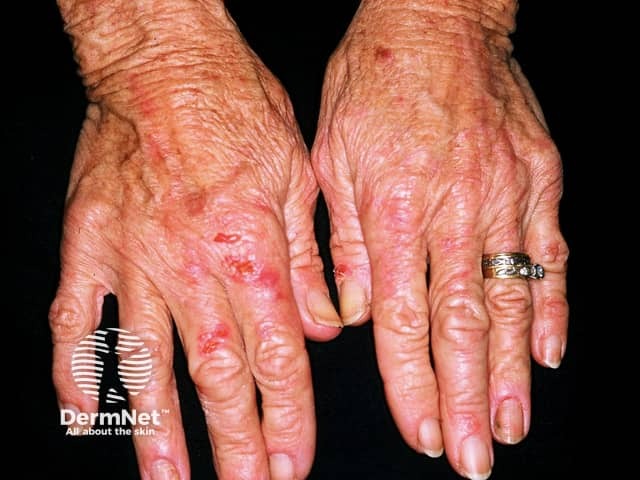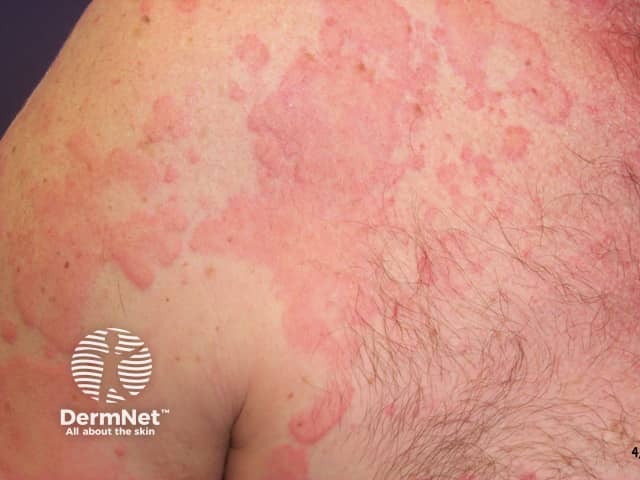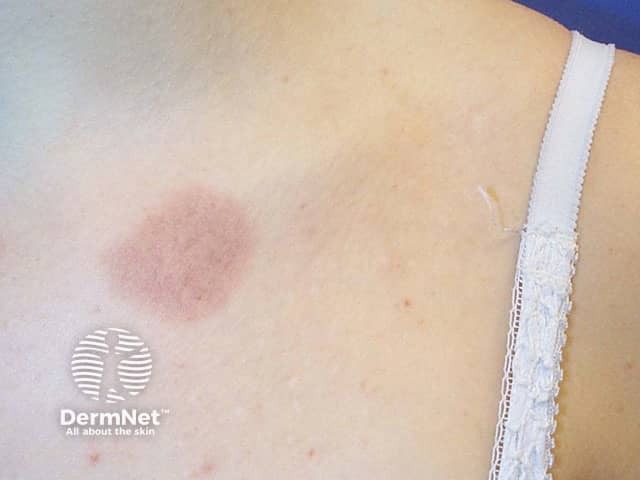Main menu
Common skin conditions

NEWS
Join DermNet PRO
Read more
Quick links
Author: Dr Delwyn Dyall-Smith FACD, Dermatologist, 2010.
Introduction Classification Side effects: general information Skin side effects: topical NSAIDs Common side effects of systemic NSAIDs Less common side effects of systemic NSAIDs Unique and most common skin reactions to systemic NSAIDs
Non-steroidal anti-inflammatory drugs (NSAIDs) are medications used regularly in the treatment of arthritis and intermittently for fever, pain and headache.
They are most commonly used systemically, usually as an oral formulation but can also be used as a suppository or administered by intramuscular injection. Topical gels and creams containing NSAIDs may be applied to sports injuries, painful joints and, most recently, for the treatment of solar (actinic) keratoses. NSAIDs are taken by children and adults.
Non-steroidal anti-inflammatory drugs can be classified by action (effect on the COX enzymes) and chemical structure as traditional, non-selective COX inhibitors or as selective COX2 inhibitors.
Non-selective COX inhibitors
Selective COX2 inhibitors
Another way to classify them is by half-life.
Many skin side effects are seen with many different medications and are not specific or diagnostic for any particular medication or chemical structure. Most are mild but they can rarely be life-threatening.
NSAIDs are one of the commonest drug groups to cause skin side effects. The gastrointestinal tract and the skin are the two body systems most likely suffer a side effect with NSAIDs.
It is difficult to estimate the frequency of skin side effects with NSAIDs as they are commonly purchased without a prescription, and only those reactions worrying enough to present to a hospital are usually recorded. Most studies assess presentations to hospital A &E (Emergency or Casualty) departments, serious reactions that require admission to hospital or study adverse drug reactions occurring in an inpatient population. In one prospective study of nearly 20,000 inpatients, 0.3% of those prescribed an NSAID developed a generalized skin reaction including morbilliform rash, Drug-induced urticaria, angioedema, serum sickness-like reaction and erythema nodosum. In a meta-analysis of randomized clinical trials, skin side effects were reported in 1–2% of patients using NSAIDs.
As with most drug-induced skin reactions, withdrawal of the trigger medication results in resolution of the rash, although this may take some months and is not universal.
Topical diclofenac gel is available for the treatment of sun-damaged skin, including actinic keratoses. Skin side effects reported in clinical trials that were seen more commonly with the active gel compared to the vehicle placebo, included allergic contact dermatitis, dryness (irritant dermatitis) and scaling.
The use of topical NSAIDs gels or creams to treat pain has been reported to cause photocontact dermatitis. Most commonly this has occurred with ketoprofen gel with an incidence of 0.013-0.028/1000. Often the reaction appears after stopping the application when the skin is next exposed to sunlight. Therefore it is usually reported in summer. The reaction commonly extends beyond the area where the gel had been applied. The reaction can be severe, requiring hospital admission in some cases. Testing has shown this to be photoallergic contact dermatitis, crossreacting with other NSAIDs including tiaprofenic acid, fenofibrate, oxybenzone and benzophenone. Bufexamac has also been reported to cause contact dermatitis.
Common non-specific skin reactions to NSAIDs are:

Pseudoporphyria

Urticaria

Fixed drug eruption
These skin side effects include:
A number of skin reactions have been reported either to occur only with systemic NSAIDs or NSAIDs appear to be a common trigger. These include:
NSAIDs can cause a pseudo-allergy due to their pharmacological effects with a prevalence rate of 0.1-0.3%. It is believed to be due to inhibition of the enzyme COX1. Typically in this condition, the reaction develops with multiple different drugs in this family, unlike a true allergy where it is a reaction to a specific drug.
Predisposing factors are:
The most common presentation of NSAID hypersensitivity is facial swelling, particularly around the eyes (angioedema). One-third of patients present with a mixed pattern of skin (angioedema and/or urticaria) and respiratory symptoms including cough, breathlessness, rhinorrhoea (runny nose), tearing or upper respiratory tract swelling.
There are four presentations recognised:
In general, selective COX2 inhibitors are well tolerated by most patients who have experienced this reaction with non-selective NSAIDs, but skin reactions have been reported rarely even with these. Total avoidance of aspirin and NSAIDs is only essential where there has been a serious reaction such as upper airway swelling.
Pseudoporphyria resembles true cutaneous porphyria tarda. It was first reported with naproxen but has subsequently been seen with other propionate type NSAIDs. It presents with skin blistering and fragility, sun sensitivity and scarring, so clinically looks like porphyria cutanea tarda, but on specific biochemical testing, there is no abnormality detected.
In children, early-onset pauciarticular arthritis (a type of arthritis affecting only one or two joints) is a major risk factor for developing this skin reaction. In one study, 11% of children treated with naproxen developed pseudoporphyria cutanea tarda after an average of 18 months. Ceasing the naproxen did not always clear the skin problems.
Patients suffering from chronic idiopathic or ordinary urticaria or dermographism may notice a worsening or relapse of their condition when taking aspirin or other NSAIDs. The rash may appear within minutes to hours after taking any one of this group of medications. It is rarely serious but often involves the mucous membranes.
True allergic reactions involving specific IgE can occur but are fortunately rare as they can be potentially fatal. They can be distinguished from the hypersensitivity/intolerance syndrome as there is usually no crossreactivity with other NSAIDs groups.
Salicylates including aspirin can cause mast cell degranulation and aggravation of symptoms in patients suffering from urticaria pigmentosa.
There was some suggestion that taking an NSAID longterm might prevent the development of nonmelanoma skin cancer. However, the most recent analyses of skin cancer prevention trials suggest that longterm use of NSAID probably does not significantly prevent skin cancer development, but perhaps short term use may.